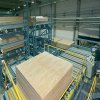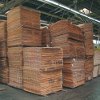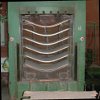Representing the plywood industry
31 December 2005As reported in WBPI’s August/September issue, the European Federation of the Plywood Industry (FEIC) held its annual meeting alongside that of the European Panel Federation (EPF) in Riga, Latvia in June.
This was only the second time that these two independent associations had held their meetings at the same venue and time and the FEIC’s comprehensive annual report, delivered on that occasion, offered an excellent opportunity to look more closely at this important sector of the European panel industry.
Like its counterpart the EPF, the FEIC does not claim to represent the whole European manufacturing industry, but it does cover a significant proportion of production, especially in the EU states, and is continually increasing its membership, with companies from non-EU states such as Russia joining up.
Members of the FEIC are not just individual panel producing companies but include national associations such as the Finnish Forest Industries Federation, the Swedish Federation of Wood and Furniture Industry and France’s Union des Fabricants de Panneaux de Contraplaqué (association of plywood manufacturers) as examples.
The administrative structure, or secretariat, of the FEIC is largely shared with the EPF; both federations are housed in the same building in Brussels and Kris Wijnendaele is secretary general of both.
Plywood producing countries with companies represented by the federation are Belgium, Bulgaria, Czech Republic, Estonia, Finland, France, Germany, Greece, Italy, Latvia, Poland, Portugal, Russia, Slovenia, Spain, Sweden, Switzerland and the Ukraine.
At the time of the AGM, 13 companies from Turkey were expected to join the FEIC, through their national association.
Of these countries, Russia has the largest installed capacity at 2,235,000m3, followed by Finland with 1,350,000m3, France with 570,000m3 and Italy with 450,000m3 (all as at the end of 2004). The smallest producer nation is Slovenia at 10,000m3.
However, utilisation of that capacity varies from 100% in Russia and Finland to 72% in France, 92% in Italy and 66% in Slovenia.
In 2004, the FEIC member companies “were able to continue their non-stop growth pattern in terms of production,said Nicola Reni in his address to the open part of the federation’s annual meeting in Riga. He reported that within the member countries, plywood production increased by 2.9% to reach a new record of 3.8 million m3.
Finland put in a strong performance, as did France, particularly with what Mr Reni described as its “dynamic coniferous plywood sector”.
On the other side of the coin, Italy was forced to close some important poplar plywood mills in early 2004, losing some 14.5% of its total national capacity in the process.
As reported in the news pages of WBPI on a number of occasions in the recent past, imports of okoumé plywood from China have caused considerable distress over the last four years to the European producers, who cannot begin to compete with the prices of these products. It is particularly hard as okoumé plywood is normally situated at the higher end of the European market.
It is in this kind of situation that federations such as the FEIC can show their true value to the industry. It took up the plywood producers’ case with the European Commission (EC), lodging a complaint in July 2003, and this led to the start of an official anti-dumping investigation by the EC in August.
The result of this was that the EC imposed anti-dumping duties of up to 48.5% against all Chinese exporters on May 17, 2004. Four Chinese companies which cooperated with the investigation were however granted reduced duties of between 8.5 and 23.9%.
The investigations of the EC continued for a further six months and resulted in an increase in duty to 66.7%.
However, this did not provide the ‘fix’ the European plywood manufacturers had hoped for. “Indeed the Chinese exporters are very inventive in finding solutions to circumvent these duties,said Mr Reni.
One such ‘solution’, he said, is to ship the plywood to Europe under a different name such as ‘redwood plywood’.
This is all happening against a back-drop of generally rising plywood imports to Europe. “Even though the imports of officially declared okoumé plywood dropped during 2004, imports of plywood in general continued to increase at a stunning pace and more than doubled in 2004 compared with 2003, up to nearly 300,000m3,said Mr Reni.
These included new Chinese plywood products such as bintangor, kedongkong and red canarium, as well as film-faced.
“Therefore, the FEIC is investigating the possibility of a new anti-dumping complaint,the president told the meeting.
But the FEIC is not just concerned with unfair imports threatening its members’ businesses. It is also involved in efforts to improve their products’ position in the market.
Thus the federation considers CE marking as an important proof of the quality of construction plywood and is therefore advocating the full implementation of the Construction Products Directive, in particular the harmonised standard EN13986. It also strongly opposes the efforts by any EU member states to “create or maintain technical barriers to the trade in construction plywood.By this Mr Reni means national standards being given precedence over EUapproved ones.
In other areas of standardisation, the president said that the new European standard EN 12369-2 is an important and very useful tool for architects, designers and engineers, because it gives them tabulated characteristic values for use in the design calculations for their structures. These values are based on the bending strength classes established in the new version of the specification standard EN 636 for plywood.
In Riga, Kris Wijnendaele announced that the FEIC is to look at the developments in trade flows – especially imports from non-EU countries – and to assess their impact on the industry’s competitiveness.
The FEIC also represents the diminishing blockboard industry in Europe, whose production fell 4.4% in 2004 versus 2003, to 256,000m3. In 1999 it stood at 306,000m3.
It is still produced in 12 FEIC member countries with Germany being the largest producer at 139,600m3 in 2004.
The FEIC’s published annual report also gives information in what it terms ‘Special country fact files’.
According to this information, Brazil’s Association for Mechanically Processed Timber reported a significant increase in plywood production in 2004, reaching 3.8 million m3 – 18% up on 2003. Exports established a new record at 2.9 million m3, with 65% of that export figure being in pine plywood and 35% in tropical timber.
Turning to China, production increased more than 100% in the four years to 2005, going from nine million m3 in 2001 to 21 million m3 today. This growth has been based on imported tropical species logs from South East Asia and Africa and softwood logs from New Zealand and Russia.
Tropical plywood production in China rose 10% to 4.4 million m3 in 2004.
India reportedly has more than 2,000 small-scale plywood production units, accounting for 1.76 million m3 of production in 2004 – all from tropical logs, nearly all of which are imported.
Indonesia’s plywood industry, on the other hand, is in decline due to the decline in its forest resources, stricter enforcement of logging regulations and falling competitiveness. Production fell from 6.7 million m3 in 2003 to 6.4 million m3 in 2004.
Japan has 50 plywood producers (and two for blockboard) and produced 4% more plywood in 2004 than 2003, rising to 3.15 million m3.
Malaysia produced 4.8 million m3 in 2004, up nearly 8% on 2003 and the highest output level ever achieved. More than 85% is exported. The industry employs 60,000 people in 177 mills.
Romania increased its plywood production by over 33% in 2004, to just over 104,000m3, with a big new poplar plywood mill being opened by the Romply company in Calarasi early last year.
According to the APA-The engineered wood association in North America, total softwood plywood production in the US was 13 million m3 in 2004. The FEIC annual report does not list Canada.



